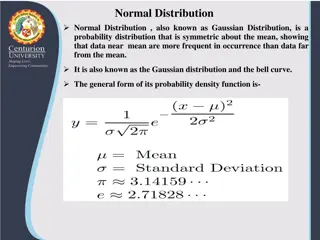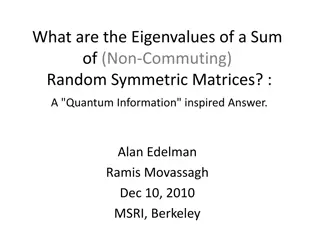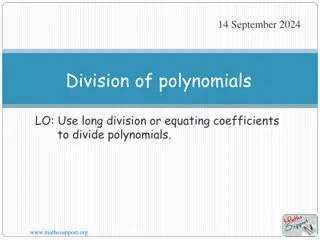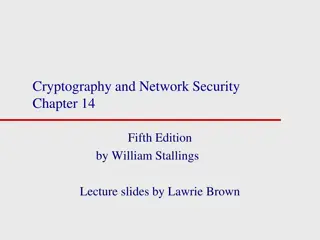
Symmetric Difference Quotient for Estimating Gradients
Learn how to estimate gradients using the symmetric difference quotient method. Start by drawing a tangent to get an initial estimate and then improve accuracy by applying numerical techniques. Discover the importance of reducing differences for better precision and compare with algebraic techniques for exact values.
Download Presentation

Please find below an Image/Link to download the presentation.
The content on the website is provided AS IS for your information and personal use only. It may not be sold, licensed, or shared on other websites without obtaining consent from the author. If you encounter any issues during the download, it is possible that the publisher has removed the file from their server.
You are allowed to download the files provided on this website for personal or commercial use, subject to the condition that they are used lawfully. All files are the property of their respective owners.
The content on the website is provided AS IS for your information and personal use only. It may not be sold, licensed, or shared on other websites without obtaining consent from the author.
E N D
Presentation Transcript
Symmetric Difference Quotient
The Symmetric Difference Quotient 1) Lets say you have a function you don t know how to differentiate such as ? = ??. 2) If you needed to estimate the gradient at point P when x = 1.5, you could draw a tangent. Zoomed in image of ? = ?? 3) How good an estimate is 2.1 for the gradient? To improve the accuracy we could use a numerical method known as the symmetric difference quotient. For this we will need to zoom in. Sub x = 1.6 into ? = ?? ? = 1.61.6 2.12 (1.6, 2.12) (3,5) Sub x = 1.5 into ? = ?? ? = 1.51.5 1.84 4) Take points on the curve either side of x = 1.5 Gradient = (5 1.84) (3 1.5)= 2.1(1??) Gradient = (2.12 1.6) P Sub x = 1.4 into ? = ?? ? = 1.41.4 1.60 (1.6 1.4)= 2.6(1??) (1.5, 1.84) 5) Our gradient estimate from drawing a tangent was 2.1, we now have a gradient of 2.6. It is important to note that this is still only an estimate. (1.4, 1.60) 6) A better estimate would be to move the two points closer still e.g. when x =1.51 and 1.49. Show that this gives a gradient of 2.582 (3dp)
Generalising your method for the Symmetric Difference Quotient Lets say you have a function that you don t know how to differentiate, lets call it ? = f(x). If you needed to estimate the gradient at a point P the symmetric difference method is always the same. 1) Pick two co-ordinates either side of P. Lets call these points A and B. Where the x-coordinate of A is x + d and the x-coordinate of B is x d. Hence if d stands for difference we have a Symmetric Difference (just meaning we go the same amount either side of P) Sub ? + ? into ? = ? ? Sub ? + ? into ? = ? ? ? = ?(? + ?) ? = ?(? + ?) A (? + ?, ) ?(? + ?) Sub ? ? into ? = ? ? ? = ?(? ?) ? = ?(? ?) Sub ? ? into ? = ? ? d 2) Sub in you new values for x into the function A (? + ?, ) ?(? + ?) d P 3) Find the gradient of the line between these two points P (? ?, ) ?(? ?) B (? ?, ) ?(? ?) d B d 4) For better accuracy make your difference smaller B 5) Note that this will only ever give an approximation and you would need to be able to differentiate a function to get the exact gradient. Gradient = ? ?+? ?(? ?) ?+? (? ?)=? ?+? ?(? ?) 2?
Now You try Print of slides 5-9, for each function you can draw a tangent to estimate a gradient and then improve your answer with the symmetric difference quotient. Remember that reducing the size of the difference will improve the accuracy of the gradient. If the function is something that you know how to differentiate then you can use your algebraic technique to do this. This will give you an exact answer. It is important to understand the phrases numerical technique and algebraic technique as exam questions may refer to them in this way.
a) By Drawing a suitable tangent find the gradient of the function at x = 1 b) Use a numerical method to find a more accurate gradient c) Use an algebraic technique to find the exact value
a) By Drawing a suitable tangent find the gradient of the function at x = 135 (hint, pay attention to the scale) b) Use a numerical method to find a more accurate gradient c) Use a numerical method to find an estimate of the gradient at x = 45 d) Use a numerical method to find an estimate of the gradient at x = 225
a) By Drawing a suitable tangent find the gradient of the function at x = 2 b) Use a numerical method to find a more accurate gradient at x = 2 c) Use the diagram to estimate the x value of the minimum point. Use the symmetrical difference method to test how accurate your estimation was d) Good questions to ponder i) Why can t you graph values when x is negative. ii) Will the graph approach a vertical asymptote. iii) is the y intercept definitely 1? iv) Is there an advanced method to differentiate this sort of function? v) what other things can I ponder?
a) By Drawing a suitable tangent find the gradient of the function at x = 2.5 (hint, pay attention to the scale) b) Use a numerical method to find a more accurate gradient c) Use an algebraic technique to find the exact value at x = 2.5
This function has an interesting gradient function. Use a numerical method to estimate the gradient at: X=0.5, x = 1, x =1.5, x = 2, Each time you do this, plot your answer onto the graph e.g. if x = 1.5 has a gradient of approx. 4.48 so you would plot the point (1.4, 4.48) onto the graph.






















